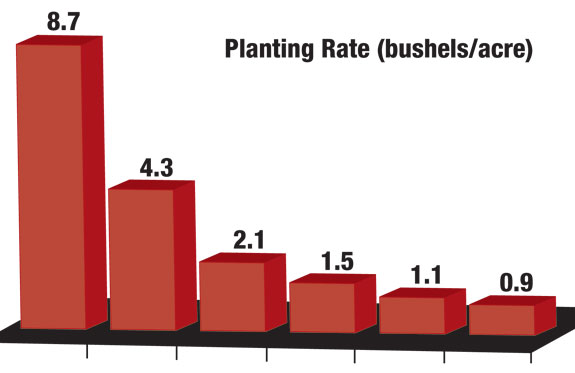If a producer chooses to sprig a field instead of seeding, careful consideration should be given to variety selection and source of sprigs.
Demand for sprigs is high and it is a long-term investment and a major expense ranging from $90 to $120 per acre depending on the variety, source of sprigs, labor and transportation cost.
This cost does not include land preparation, fertilization and weed control. Using sprigs that have poor viability could results in a poor stand with low productivity and undesirable for hay production or grazing management.
Bermudagrass is very productive perennial warm-season grass and is very tolerant of drought conditions.
There are several factors that are usually conducive to stand failure:
• Using desiccated or poor-quality sprigs
• Planting when there is inadequate soil moisture and elevated summer temperatures
• Planting sprigs too deep
• Poorly prepared seed bed
• Poor weed control
• Poor fertility
• Severe grazing too early before plants are well established
Weed control is a very important part of the establishment process to reduce water, nutrient and light competition with the new plant growth.
A pre-emergence herbicide can be applied to reduce early weed competition immediately after planting, but before the emergence of new growth.
2,4-D or other similar herbicides approved for forage crops could be applied 30 to 40 days after sprigging for control of broadleaf weeds that escaped the pre-emergence application.
Contact the local County Extension Office for herbicide recommendations or consult the Weed Control Guidelines.
Soil testing and fertilizing should be the first practice in establishing hybrid bermudagrass. Acidity should be reduced by liming.
Based on soil test recommendations, apply phosphorus (P) and 50 percent of the recommended potassium, along 30 lb/ac of nitrogen as soon as the bermudagrass plants start to grow.
Then, apply additional 50 lb/ac of nitrogen along with the other 50 percent of the recommended K approximately 30 days later or when the runners (stolons) begin to develop.
If poultry litter will be used as nutrient source, determine the manure nutrient content and apply the needed amount to supply the N, P and K recommendations.
Keep in mind that additional N might be needed when using manure applications. Also, manure could be incorporated when preparing the seed bed.
Good seedbed preparation is vital for establishment success when sprigging a hybrid bermudagrass. A well-drained soil is preferred.
If common bermudagrass is present in the area for new establishment, keep the soil weed free by deeply turning it or by spraying Roundup® during the growing season prior to establishment.
Determining the planting method and planting rates are also very important. Sprigs can be planted by commercial sprig planters at a depth of 2 to 3 inches.
Both sprigs and tops can be broadcast on the surface with a spinner-type grass planter (slinger), but this method could increase desiccation of the plant material and reduce establishment.
Planting rates for sprigs are 30 to 40 bushels per acre [~1500 lb/ac, 1.25 cubic feet, ~1 round bale/acre or 16 square bales/acre (1 square bale, 60 lbs = 3 bushels of sprigs; assuming 1 bushel= 20 lb sprigs)].
Plating tops can be successful, but it needs to be done when changes of adequate rainfall might be favorable (late May to July). The faster a stand is desired, the more sprigs should be planted.
Higher planting rates will ensure rapid colonization and ground coverage (Figure 1), but those are only recommended if the planting material is readily available or could be obtained at a low cost.
Green tops can also be used as planting materials. Tops should be planted at 15 to 20 bales (60 to 80 lbs per bale of freshly cut material) per acre. This would give you about 1200 – 1500 lbs per acre of freshly cut.
Bales would be heavier, but the material is baled just for transportation. The number of bales will depend on the weight per bale. There are also planting devices that could help broadcast large roll bales of the material.
A device called a “crimper” usually helps pushing long tops (stems) into the soil. A disk set straight will also accomplish the pushing of the material into the soil.
After planting, material should be covered with a disk harrow and the soil should be packed with a heavy cultipacker or land roller. A cultipacker should not be used on heavy clay soils because it could lead to compaction.
Driving the tractor back and forth could be used as alternative method in small areas. This will help to maintain the soil moist around the planted material.
Selecting the plating material and ensuring proper time of planting are important components of establishing hybrid bermudagrass. Most sprigs consist of a mixture of underground rhizomes, crowns, and stolons (runners).
Most sprigs could be planted from March to July depending on the location and weather conditions. Sprigs usually have a better chance of survival under cooler conditions.
One disadvantage of using sprigs in early spring is the low levels in energy reserves necessary for shoot development (sprouting).
Digging sprig should be done before bermudagrass breaks dormancy or later in the season when plants have accumulated enough root reserves.
Planting green mature stems or tops is different than planting sprigs.
They can be planted form late May to July, but the material should not be collected until the grass has matured for at least eight to ten weeks, is 18 to 24 inches long and has six or more nodes.
Tops should be cut with a sickle mower, baled immediately and planted as soon as possible before they go through a heating cycle.
Tops should be planted during a cloudy and rainy period because moisture conditions should be ideal for this establishment method to succeed.
During bright summer days, soil temperature increases causing the top to either dry out or scald. If plating a small area, tops could be pitched and spread on a trailer.
The material should be scattered and disked into soil moisture before it wilts; tops can dry out and die within minutes.
Pack the soil around the new runners using a roller to avoid excessive moisture loss and ensure good soil-to-nodes contact.
It is important that new young plants from sprigs or tops have at least three months to develop a strong root system and store carbohydrates before the onset of cold weather.
Late plantings should not be harvested and should be allowed to have plenty of top growth throughout the winter to protect plants from freezing.
The accumulated top growth should be removed in the spring following establishment by clipping. Burning is not recommended until the second season.
Burning should be done late February to early March and it should be done when the soil surface is moist and under windy conditions to have a cooler fire.
Tifton 85 bermudagrass establishes more rapidly by tops than other bermudagrass hybrids and with adequate and continuous soil moisture, complete coverage of Tifton 85 should occur in 90 to 100 days.
To increase the success of establishment, use only fresh and healthy material (sprigs and tops) that has been under a good fertility program.
Sprigs should be thick, tan to amber-colored and crisp. Sprigs should be kept under moist and cool conditions and in the shade to ensure survivability if plating is delayed.

Exposure of sprigs to the sun and wind after digging will increase desiccation once they are dug and rapidly reduce their viability (Table 1).
If sprigs have been dug and not planted within 24 hours, they should be soaked in water for 12 to 15 hours before planting.
If a producer intends to establish a large acreage of hybrid bermudagrass, it might be wise to establish a small area of pure weed-free grass as a nursery.
In that nursery, planting material can be harvested for additional plantings later in the season or in subsequent years.
This establishment method could be risky because producing week sprigs could increase the risk of establishment failure over more than one season and it could be more costly.
Obtaining good-quality planting material (sprigs or tops) that is free from common bermudagrass or other weedy species form reputable sources is essential.
Think carefully about your source of sprigs and sprigging contract. Make sure that sprigs are at least 90 percent of the “pure bermudagrass variety” being offered.
It is very hard to find fields that pure stands and it is difficult to distinguish varieties from sprigs.
A sprigging contract might warrant an establishment percentage in case of stand failure and will ensure that the person hired in the first place will do the re-sprigging.
Contact your local Extension Office for information that might be available related to spriggers. FG
—Mississippi State University Extension newsletter Forage News, vol. 4 issue 4, April 2011
Rocky Lemus
Extension Forage Specialist
Mississippi State University Extension
rlemus@ext.msstate.edu











